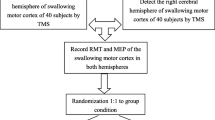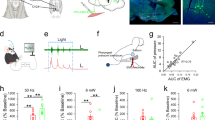Abstract
The aim of this study was to determine the optimum frequency of electroacupuncture (EA) for the treatment of dysphagia after stroke. Male C57BL/6 J mice were randomly divided into five groups: normal, model, 2 Hz, 50 Hz, and 100 Hz groups. All mice received a photochemical ischemia, except the normal group. The EA parameters were 1 mA for 15 min, with different frequencies (2, 50, and 100 Hz) applied. After a three day treatment, neuronal activation was detected by the expression of c-Fos. A multi-channel electrophysiological technique was used to assess the discharge of contralateral neurons and the neuron types in each group. The concentration of brain-derived neurotrophic factor (BDNF) in the contralateral neurons was also examined. In addition, the dysfunction of swallowing in mice was calculated according to the lick counts and the lick–lick interval within a certain period of time. The number of c-Fos neurons (P < 0.05) and the expression of BDNF (P < 0.05) increased after the 2 Hz EA treatment. The total frequency of neuron discharge in the 2 Hz group increased compared with the model group (P < 0.05). The pattern of sorted neuron populations was similar between the normal and 2 Hz groups. Consistent with these results, the lick counts increased (P < 0.05) and the lick–lick interval decreased after the 2 Hz EA treatment, which indicated a functional improvement in swallowing. These results indicated that the 2 Hz EA treatment had a good effect on dysphagia after stroke.





Similar content being viewed by others
Abbreviations
- EA:
-
Electroacupuncture
- BDNF:
-
Brain-derived neurotrophic factor
- TMS:
-
Transcranial magnetic stimulation
- PES:
-
Pharyngeal electrical stimulation
- PBS:
-
Phosphate-buffered saline
- PCA:
-
Principal component analysis
- EM:
-
Expectation maximization.
- BSA:
-
Bovine serum albumin
- M1:
-
Primary motor cortex
- PSD:
-
Power spectral density
- NGF:
-
Nerve growth factor
- GAP-43:
-
Growth associated protein-43
- VLM:
-
Ventrolateral medulla
- NA:
-
Nucleus ambiguus
- CPG:
-
Central pattern generator
References
Bullitt E (1990) Expression of c-fos-like protein as a marker for neuronal activity following noxious stimulation in the rat. J Comp Neurol 296:517–530
Chen XH, Han JS (1992) Analgesia induced by electroacupuncture of different frequencies is mediated by different types of opioid receptors: another cross-tolerance study. Behav Brain Res 47:143–149
Cohen DL, Roffe C, Beavan J, Blackett B, Fairfield CA, Hamdy S, Havard D, McFarlane M, McLauglin C, Randall M, Robson K, Scutt P, Smith C, Smithard D, Sprigg N, Warusevitane A, Watkins C, Woodhouse L, Bath PM (2016) Post-stroke dysphagia: a review and design considerations for future trials. Int J Stroke 11:399–411
Ding R, Logemann JA (2000) Pneumonia in stroke patients: a retrospective study. Dysphagia. 15:51–57
Chorev E, Epsztein J, Houweling AR, Lee AK, Brecht M (2009) Electrophysiological recordings from behaving animals--going beyond spikes. Curr Opin Neurobiol 19:513–519
Tan Feng, Jian Wang, Jing Xian Liu, Chen Wang, Miaodan Li, Yong Gu (2018) Electroacupuncture stimulates the proliferation and differentiation of endogenous neural stem cells in a rat model of ischemic stroke. Exp Ther Med 16:4943–4950
Gordon C, Hewer RL, Wade ADT (1987) Dysphagia in acute stroke. Brit Med J 295:411–414
Guo ZL, Moazzami AR, Longhurst JC (2004) Electroacupuncture induces c-Fos expression in the rostral ventrolateral medulla and periaqueductal gray in cats: relation to opioid containing neurons. Brain Res 1030:103–115
Guo ZL, Malik S (2019) Acupuncture activates a direct pathway from the nucleus tractus solitarii to the rostral ventrolateral medulla. Brain Res 1708:69–77
Han JS (2003) Acupuncture: neuropeptide release produced by electrical stimulation of different frequencies. Trends Neurosci 26:17–22
Hernandez-Morato I, Sharma S, Pitman MJ (2016) Changes in neurotrophic factors of adult rat laryngeal muscles during nerve regeneration. Neuroscience 333:44–53
Katoh-Semba R, Asano T, Ueda H, Morishita R, Takeuchi IK, Inaguma Y, Kato K (2002) Riluzole enhances expression of brain-derived neurotrophic factor with consequent proliferation of granule precursor cells in the rat hippocampus. FASEB J 16:1328–1330
Kim YR, Ahn SM, Pak ME, Lee HJ, Jung DH, Shin YI, Shin HK, Choi BT (2018) Potential benefits of mesenchymal stem cells and electroacupuncture on the trophic factors associated with neurogenesis in mice with ischemic stroke. Sci Rep 8:2044
Kowianski P, Lietzau G, Czuba E, Waskow M, Steliga A, Morys J (2018) BDNF: a key factor with multipotent impact on brain Signaling and synaptic plasticity. Cell Mol Neurobiol 38:579–593
Kwon M, Fernandez JR, Zegarek GF, Lo SB, Firestein BL (2011) BDNF-promoted increases in proximal dendrites occur via CREB-dependent transcriptional regulation of cypin. J Neurosci 31:9735–9745
Lee J, Duan W, Mattson MP (2002) Evidence that brain-derived neurotrophic factor is required for basal neurogenesis and mediates, in part, the enhancement of neurogenesis by dietary restriction in the hippocampus of adult mice. J Neurochem 82:1367–1375
Li LX, Deng K, Qu Y (2018) Acupuncture treatment for post-stroke dysphagia: an update meta-analysis of randomized controlled trials. Chin J Integr Med 24:686–695
Lian D, He D, Wu J, Liu Y, Zhu M, Sun J, Chen F, Li L (2016) Exogenous BDNF increases neurogenesis in the hippocampus in experimental Streptococcus pneumoniae meningitis. J Neuroimmunol 294:46–55
Lu L, Zhang XG, Zhong LL, Chen ZX, Li Y, Zheng GQ, Bian ZX (2016) Acupuncture for neurogenesis in experimental ischemic stroke: a systematic review and meta-analysis. Sci Rep 6:19521
Meng NH, Wang TG, Lien IN (2000) Dysphagia in patients with brainstem stroke: incidence and outcome. Am J Phys Med Rehabil 79:170–175
Obermeyer JM, Tuladhar A, Payne SL, Ho E, Morshead CM, Shoichet MS (2019) Local delivery of brain-derived neurotrophic factor enables behavioral recovery and tissue repair in stroke-injured rats. Tissue Eng Part A 25:1175–1187
Pang G, Zhang G (2014) Subcellular localization of serotonin 2 a receptor in dorsal hippocampal CA1 area and its effect on neuronal firing. Chin Pharmacol Bull 30:1262–1266
Qi D, Wu S, Zhang Y, Li W (2016) Electroacupuncture analgesia with different frequencies is mediated via different opioid pathways in acute visceral hyperalgesia rats. Life Sci 160:64–71
Rauskolb S, Zagrebelsky M, Dreznjak A, Deogracias R, Matsumoto T, Wiese S, Erne B, Sendtner M, Schaeren-Wiemers N, Korte M (2010) Global deprivation of brain-derived neurotrophic factor in the CNS reveals an area-specific requirement for dendritic growth. J Neurosci 30:1739–1749
Segal RA (2003) Selectivity in neurotrophin signaling: theme and variations. Annu Rev Neurosci 26:299–330
Shi J, Ye Q, Zhao J, Liu J, Xu Z, Yi W, Xu N (2018) EA promotes swallowing via activating swallowing-related motor neurons in the nucleus Ambiguus. Brain Res 1718
Smith PA (2014) BDNF: no gain without pain? Neuroscience 283:107–123
Smithard DG, Smeeton NC, Wolfe CD (2007) Long-term outcome after stroke: does dysphagia matter? Age Ageing 36:90–94
Su Y, Li P, Zhao G (2004) Electroacupuncture treatment for 45 cases of postapoplectic dysphagia. J Tradit Chin Med 24:129–130
Takekawa T, Isomura Y, Fukai T (2010) Accurate spike sorting for multi-unit recordings. Eur J Neurosci 31:263–272
Tateyama Y, Oyama K, Shiraishi M, Iijima T, Tsutsui KI (2017) Robust, highly customizable, and economical multi-channel electrode for chronic multi-unit recording in behaving animals. Neurosci Res 125:54–59
Vickers AJ, Vertosick EA, Lewith G, MacPherson H, Foster NE, Sherman KJ, Irnich D, Witt CM, Linde K (2018) Acupuncture for chronic pain: update of an individual patient data meta-analysis. J Pain 19:455–474
Wang L, Chang X, She L, Xu D, Huang W, Poo M (2015) Autocrine action of BDNF on dendrite development of adult-born hippocampal neurons. J Neurosci 35:8384–8393
Wilson RD (2012) Mortality and cost of pneumonia after stroke for different risk groups. J Stroke Cerebrovasc Dis 21:61–67
Wood F, Fellows M, Donoghue J, Black M (2004) Automatic spike sorting for neural decoding. Conf Proc IEEE Eng Med Biol Soc 6:4009–4012
Ye Q, Xie Y, Shi J, Xu Z, Ou A, Xu N (2017) Systematic review on acupuncture for treatment of dysphagia after stroke. Evid Based Complement Alternat Med 2017:6421852
Ye Q, Liu C, Shi J, You H, Zhao J, Liu J, Xu N, Xu Z (2019) Effect of electro-acupuncture on regulating the swallowing by activating the interneuron in ventrolateral medulla (VLM). Brain Res Bull 144:132–139
Zhang JH, Wang D, Liu M (2014) Overview of systematic reviews and meta-analyses of acupuncture for stroke. Neuroepidemiology. 42:50–58
Zhang L, Xu N, Li R, Wang L (2018) Clinical study of electroacupuncture with different frequencies at Lianquan (CV 23) and Fengfu (GV 16) for stroke dysphagia. Zhongguo Zhen Jiu 38:115–119
Zhao XF, Du Y, Liu PG, Wang S (2012) Acupuncture for stroke: evidence of effectiveness, safety, and cost from systematic reviews. Top Stroke Rehabil 19:226–233
Acknowledgements
We are thankful for the kindly support of all the workers at the animal facility of Jilin University for the animal care and the technical method guide.
Funding
This study is supported by the National Natural Science Foundation of China (No. 81774406). The funding bodies do not play roles in study design, data collection, analysis, interpretation of results, and the manuscript.
Author information
Authors and Affiliations
Contributions
N X designed and guaranteed the whole experiment studies; S Y, Y L, S C, H L, C J, S Y, Q Y and Y Z carried out all the experiments, analyzed the statistical data, drafted the manuscript; N X edited and revised the whole manuscript; all authors read and approved the final manuscript.
Corresponding author
Ethics declarations
Ethics Approval and Consent to Participate
All procedures had the approval of the Animal Ethics Committee of the Guangzhou University of Chinese Medicine.
Competing Interests
The authors declare that they have no competing interests.
Additional information
Publisher’s Note
Springer Nature remains neutral with regard to jurisdictional claims in published maps and institutional affiliations.
Rights and permissions
About this article
Cite this article
Yao, S., Liu, Y., Cui, S. et al. Effect of Different Frequencies of Electroacupuncture on Post-Stroke Dysphagia in Mice. J Mol Neurosci 70, 1871–1879 (2020). https://doi.org/10.1007/s12031-020-01580-1
Received:
Accepted:
Published:
Issue Date:
DOI: https://doi.org/10.1007/s12031-020-01580-1




